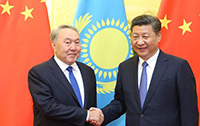Ukraine crisis little threat to energy prices
By Julian Jessop (China Daily) Updated: 2014-03-24 08:28
The crisis in Ukraine still has the potential to have a significant impact on the European economy and global financial markets. Nonetheless, the most likely outcome appears to be a limited exchange of sanctions and a diplomatic settlement that results in the crisis dropping out of the headlines again. Even if tensions do escalate the balance of economic and financial power favors the West rather than Russia.
Admittedly it is far from certain what will happen next. But it is clear that all sides want to prevent the crisis from spiraling out of control. Russia has achieved its main aim of annexing Crimea and it is unrealistic to expect the peninsula to be handed back. The West may therefore settle for a negotiated solution that guarantees the security of the rest of Ukraine and that of the other former Soviet satellites.
In the meantime, the sanctions imposed by the United States and European Union have been limited to visa restrictions and asset freezes targeted at a small number of Russian officials. Crucially, there seems to be little appetite for broader economic sanctions. Nonetheless, the threat of a further escalation has already undermined Russia's financial markets and prompted rating agencies to downgrade the country's outlook. We expect Russia's GDP to grow by just 1 percent this year, and it would not take much to tip the economy into recession.
Europe's overall exposure to Russia through trade and financial links is small, but Russia does supply around 30 percent of Europe's natural gas, as well as significant amounts of oil and coal. Germany and Finland are particularly vulnerable to any disruption to the supply of Russian energy, while the Netherlands, Poland, Turkey and Italy are also highly exposed.
However, several factors should limit the upside for global energy prices in the near term, and might even increase the downside risks to prices on a longer horizon. For a start, despite threats from some officials in Moscow, Russia seems unlikely to take the first steps in restricting the flow of energy to the West. Any such move could simply backfire by further damaging the country's reputation as a business partner and prompt EU customers to seek more secure supplies elsewhere. What's more, Russia badly needs the revenues and may actually have to cut prices to increase sales to other markets (including China).
Equally, the West is very reluctant to impose economic sanctions that would target Russia's energy exports, given the understandable caution of Germany in particular. But if the West did go down this route, the US and EU would presumably announce additional measures at the same time to limit the impact on overall supply and prices, notably releases from strategic reserves.
Indeed, some commentators have already argued that the US should preemptively sell a large amount of its Strategic Petroleum Reserve to reduce global oil prices and undermine Russia's economy. We think this is unlikely to happen, partly because of the collateral damage to other (more friendly) oil producers. But a test sale from the SPR earlier this month was clearly a warning shot against any attempt by Russia to restrict supply. Overall, Russia would probably still come off worst in any exchange of tit-for-tat measures in the energy market, despite the potential harm to some European customers.
This leaves the possibility of disruption to the flow of Russian energy supplied via the Ukraine, whether by accident or design. However, the risks here are smaller than in the past. The share of Russian gas exports to Europe transiting Ukraine has fallen from 80 percent to 50-60 percent since the Nord Stream pipeline (direct to Germany) became operational in 2011. Seasonal demand is also set to decline as the warmer summer months approach, while the unusually mild winter means that European gas reserves are relatively high.
The upshot is that any rise in global energy prices due to an escalation of sanctions should prove to be short-lived. Indeed, the Ukraine crisis may add to the downward pressures on oil and gas prices by accelerating the drawdown of strategic oil reserves and by hastening the development of alternative sources of energy for Europe, including shale and imports from the US.
Instead, one of the few lasting winners from the Ukraine crisis may be the price of gold. The collapse in the gold price in 2013 prompted some to conclude that the precious metal had lost its safe-haven status. However, this status is confirmed in bad times, not good, and gold has again passed that test. We therefore continue to expect gold to climb to at least $1,450 per ounce this year.
The author is chief global economist at Capital Economics, the leading macroeconomics research provider.
(China Daily 03/24/2014 page11)




